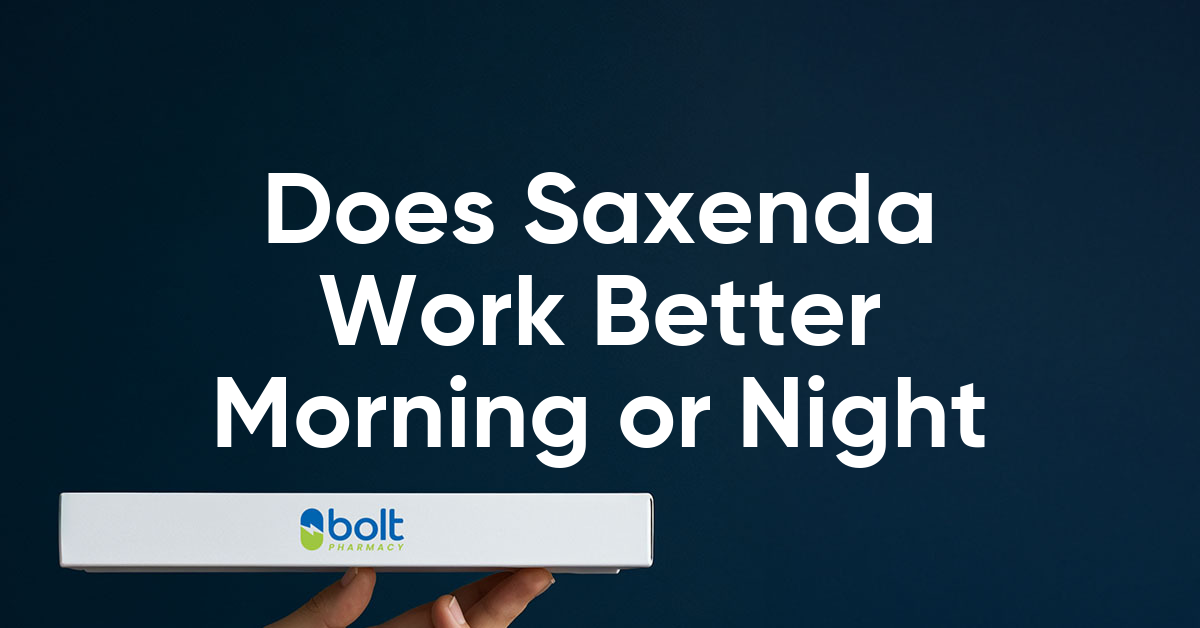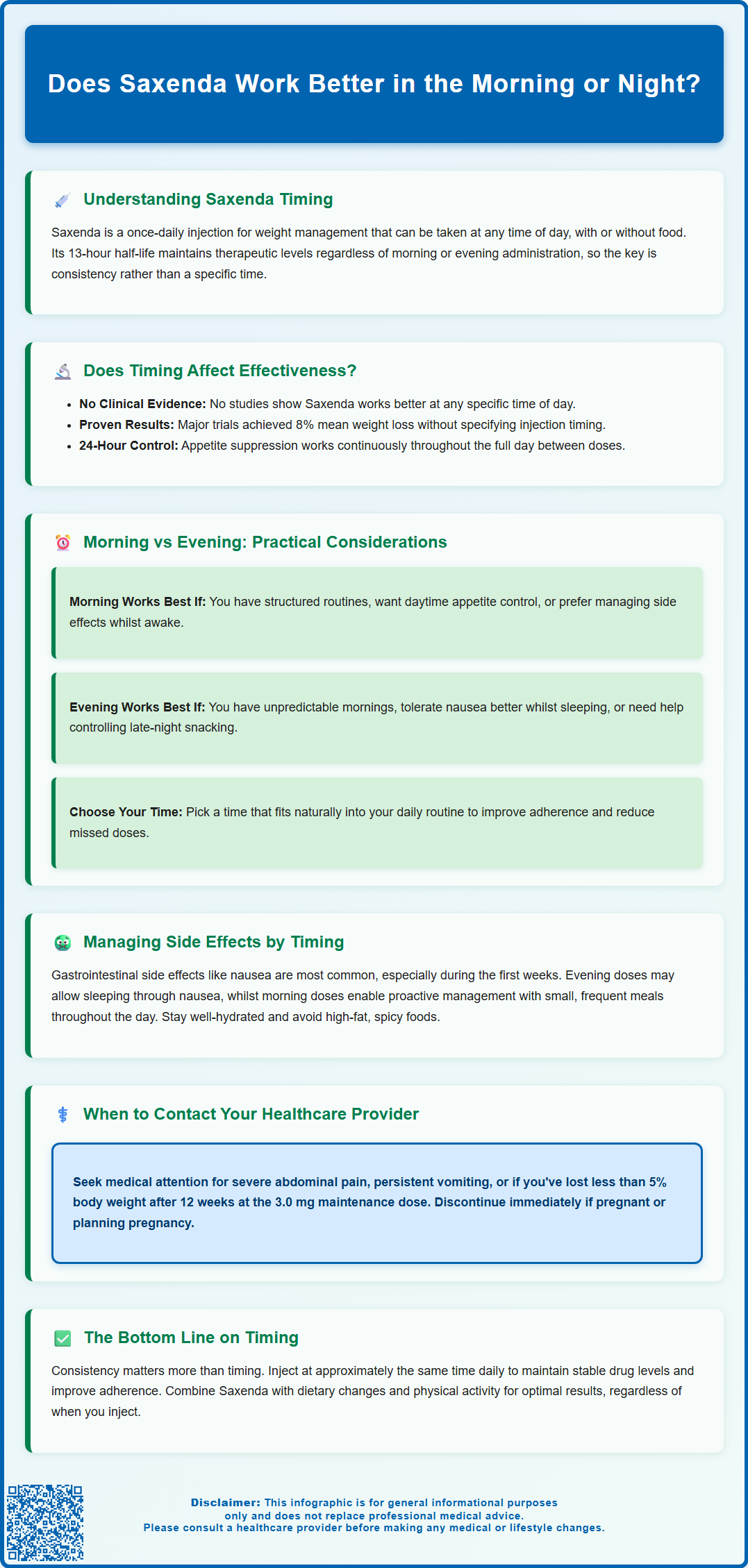Wegovy®
A weekly GLP-1 treatment proven to reduce hunger and support meaningful, long-term fat loss.
- ~16.9% average body weight loss
- Boosts metabolic & cardiovascular health
- Proven, long-established safety profile
- Weekly injection, easy to use

Does Saxenda work better in the morning or night? This is a common question amongst patients prescribed liraglutide 3.0 mg for weight management. Saxenda, a GLP-1 receptor agonist licensed by the MHRA, can be administered at any time of day with equal effectiveness. Clinical evidence shows no pharmacological advantage to morning versus evening injections. The medication's 13-hour half-life ensures continuous appetite regulation regardless of timing. What matters most is consistency—injecting at approximately the same time daily maintains stable therapeutic levels and supports adherence. This article examines the evidence, practical considerations, and clinical guidance to help you determine the most suitable injection time for your individual circumstances.
Summary: Saxenda works equally well whether administered in the morning or at night, as clinical evidence shows no difference in effectiveness based on injection timing.
Saxenda (liraglutide 3.0 mg) is a glucagon-like peptide-1 (GLP-1) receptor agonist licensed by the MHRA for weight management in adults with a body mass index (BMI) of 30 kg/m² or greater, or 27 kg/m² or greater in the presence of weight-related comorbidities. It is also licensed for adolescents (12 to <18 years) with obesity and body weight above 60 kg. The medication works by mimicking the action of the naturally occurring hormone GLP-1, which regulates appetite and food intake through effects on the brain's satiety centres.
Saxenda is administered as a once-daily subcutaneous injection that can be given at any time of day, with or without food. Treatment starts at 0.6 mg daily and is up-titrated weekly by 0.6 mg increments to the maintenance dose of 3.0 mg as tolerated. The flexibility in timing is a deliberate feature of the medication's design, allowing patients to integrate treatment into their daily routines in a way that promotes adherence. According to the Saxenda Summary of Product Characteristics (SmPC), liraglutide has a half-life of approximately 13 hours, meaning the medication maintains therapeutic levels in the bloodstream regardless of whether it is administered in the morning or evening.
The SmPC approved by the MHRA makes no official recommendation favouring morning or night administration. The prescribing information emphasises consistency rather than specific timing—patients are advised to inject Saxenda at approximately the same time each day to maintain stable drug levels and establish a reliable routine. This approach helps ensure optimal therapeutic effect whilst minimising the risk of missed doses.
Understanding that Saxenda's effectiveness is not inherently time-dependent allows patients and healthcare professionals to focus on individualised treatment plans that account for lifestyle factors, side effect profiles, and personal preferences when determining the most suitable injection time.
From a pharmacological perspective, there is no clinical evidence demonstrating that Saxenda works better when administered in the morning versus at night, or vice versa. The medication's mechanism of action—slowing gastric emptying, reducing appetite, and increasing feelings of fullness—operates continuously once therapeutic blood levels are achieved, regardless of injection timing. According to the SmPC, the drug reaches maximum plasma concentration approximately 11 hours after subcutaneous injection, and its effects on appetite regulation persist throughout the 24-hour dosing interval.
Clinical trials that established Saxenda's efficacy, including the SCALE (Satiety and Clinical Adiposity – Liraglutide Evidence) programme, did not specifically investigate morning versus evening administration as an efficacy modifier. The SCALE Obesity and Prediabetes trial showed a mean weight loss of approximately 8% at 56 weeks compared to placebo, with 63.2% of patients achieving ≥5% weight loss and 33.1% achieving ≥10% weight loss. These outcomes were achieved without specifying a particular time of day for injections, reinforcing that consistency of use is more important than specific timing.
NICE Technology Appraisal 664 on liraglutide for managing overweight and obesity does not stipulate optimal timing for administration. The focus remains on appropriate patient selection, dose titration, and monitoring of treatment response rather than circadian considerations.
Whilst some patients report subjective differences in appetite control or side effect profiles based on injection timing, these observations are anecdotal rather than evidence-based. Individual responses to medication can vary due to factors such as meal patterns, sleep schedules, and metabolic differences, but there is no robust clinical data suggesting superior efficacy with morning or evening administration. The key determinant of Saxenda's effectiveness remains consistent daily use at the prescribed dose, combined with lifestyle modifications including reduced calorie intake and increased physical activity.

When deciding between morning or night administration, practical lifestyle factors often prove more influential than pharmacological considerations. Many patients find that establishing a consistent injection routine aligned with existing daily habits—such as morning tooth brushing or evening skincare—significantly improves adherence. The NHS emphasises that medication adherence is a critical factor in treatment success, and choosing a time that fits naturally into one's schedule reduces the likelihood of missed doses.
Morning administration may be preferred by individuals who:
Have structured morning routines that facilitate remembering medication
Experience appetite suppression that helps control daytime food intake
Prefer to manage any initial side effects during waking hours when they can respond appropriately
Find that evening injections interfere with sleep or cause nocturnal discomfort
Conversely, evening or night-time administration might suit those who:
Have unpredictable morning schedules due to work or family commitments
Experience nausea or gastrointestinal side effects that are better tolerated whilst sleeping
Find that evening injection helps control late-night snacking or appetite the following morning
Have more time and privacy for injection preparation and administration in the evening
It is important to note that changing injection time is permissible if the new time better suits your circumstances. According to the SmPC, if you miss a dose, take it as soon as you remember if there are at least 12 hours until your next scheduled dose. If there are fewer than 12 hours until the next dose, skip the missed dose and resume your normal schedule the following day. If you wish to permanently alter your injection schedule, discuss this with your GP or prescribing clinician to ensure safe transition.
The injection site—abdomen, thigh, or upper arm—can be rotated regardless of timing, and this rotation is recommended to prevent lipodystrophy (changes in fat tissue at injection sites).
Gastrointestinal side effects—including nausea, vomiting, diarrhoea, and constipation—are the most commonly reported adverse reactions with Saxenda, particularly during dose escalation. These effects result from the medication's mechanism of slowing gastric emptying and are typically most pronounced in the first few weeks of treatment. Strategic timing of injections may help some patients better manage these symptoms, though individual responses vary considerably.
Patients who experience significant nausea might find that evening administration allows them to sleep through some of the gastrointestinal effects. However, others find that morning injection allows them to manage nausea proactively with small, frequent meals throughout the day and ensures symptoms have largely resolved before bedtime.
Practical strategies for managing side effects include:
Starting with smaller, more frequent meals rather than three large meals
Avoiding high-fat, spicy, or rich foods that may exacerbate nausea
Staying well-hydrated, particularly if experiencing vomiting or diarrhoea
Eating slowly and stopping when feeling comfortably full
For patients with diabetes who are taking Saxenda alongside insulin or insulin secretagogues (such as sulfonylureas), there is an increased risk of hypoglycaemia. Dose adjustments of these medications may be necessary, and timing considerations should be discussed with your healthcare provider.
If side effects become severe or persistent, contact your GP or prescribing clinician. They may recommend temporarily reducing the dose, slowing the titration schedule, or providing additional symptomatic management. According to the SmPC, treatment should be discontinued if patients experience severe gastrointestinal symptoms or if weight loss targets are not achieved (less than 5% weight loss after 12 weeks at the maintenance dose of 3.0 mg).
Injection site reactions—such as redness, itching, or bruising—are generally unrelated to timing but can be minimised by proper injection technique, site rotation, and ensuring the medication has reached room temperature before administration. If you develop persistent lumps, significant pain, or signs of infection at injection sites, seek medical advice promptly.
Patients are encouraged to report any suspected side effects via the MHRA Yellow Card Scheme (yellowcard.mhra.gov.uk).
Healthcare professionals should provide individualised guidance on Saxenda timing based on comprehensive patient assessment. The prescribing decision should consider the patient's daily routine, work schedule, meal patterns, existing medication regimen, and any comorbidities that might influence optimal administration time. During initial consultations, discuss both morning and evening options, explaining that flexibility exists and adjustments can be made based on the patient's experience during treatment.
Key clinical recommendations include:
Emphasise that consistency is paramount—injecting at approximately the same time daily maintains stable therapeutic levels and establishes routine
Advise patients to choose a time when they can reliably remember and access their medication and injection supplies
Provide clear instructions on what to do if a dose is missed: take the missed dose as soon as remembered if there are at least 12 hours until the next scheduled dose; otherwise skip and resume the normal schedule the following day
Monitor treatment response at regular intervals (typically 4-weekly initially) and enquire about adherence, side effects, and whether injection timing is working well
Review concomitant medications, as Saxenda may delay absorption of oral medications due to delayed gastric emptying
According to the SmPC, Saxenda should only be continued beyond 12 weeks if patients have lost at least 5% of their initial body weight. Regular monitoring should include weight, BMI, waist circumference, and assessment of weight-related comorbidities. Healthcare professionals should also provide ongoing support for dietary modification and physical activity, as pharmacotherapy is most effective when combined with comprehensive lifestyle intervention.
For patients experiencing persistent difficulties with side effects or adherence despite timing adjustments, consider referral to Tier 3 or Tier 4 specialist weight management services. These multidisciplinary teams can provide enhanced support, including dietetic input, psychological interventions, and specialist medical review.
Patient safety advice: Saxenda is contraindicated during pregnancy and breastfeeding, and should be discontinued if pregnancy is planned or occurs. Contact your GP urgently if you experience severe abdominal pain (which may indicate pancreatitis), persistent vomiting preventing fluid intake, signs of gallbladder disease, or symptoms of thyroid tumours (neck lump, difficulty swallowing, persistent hoarseness). Routine monitoring of thyroid function is not required, but report any concerning symptoms promptly.
Yes, you can change your Saxenda injection time if the new schedule better suits your routine. Discuss the transition with your GP or prescribing clinician to ensure safe adjustment, and maintain consistency once you establish the new timing.
Some patients find that evening administration allows them to sleep through gastrointestinal side effects such as nausea, though individual responses vary. Others prefer morning injections to manage symptoms proactively during waking hours.
If you miss a dose, take it as soon as you remember provided there are at least 12 hours until your next scheduled dose. If fewer than 12 hours remain, skip the missed dose and resume your normal schedule the following day without doubling up.
The health-related content published on this site is based on credible scientific sources and is periodically reviewed to ensure accuracy and relevance. Although we aim to reflect the most current medical knowledge, the material is meant for general education and awareness only.
The information on this site is not a substitute for professional medical advice. For any health concerns, please speak with a qualified medical professional. By using this information, you acknowledge responsibility for any decisions made and understand we are not liable for any consequences that may result.
Lorem ipsum dolor sit amet, consectetur adipiscing elit, sed do eiusmod tempor incididunt ut labore et dolore magna aliqua. Ut enim ad minim veniam, quis nostrud exercitation ullamco laboris nisi ut aliquip ex ea commodo consequat. Duis aute irure dolor in reprehenderit in voluptate velit esse cillum dolore eu fugiat nulla pariatur.
Block quote
Ordered list
Unordered list
Bold text
Emphasis
Superscript
Subscript